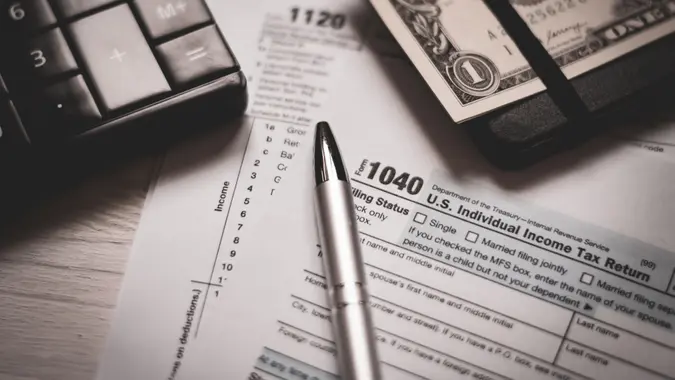2025 Tax Brackets May Lead to More Money in Your Paycheck — Here’s How

Commitment to Our Readers
GOBankingRates' editorial team is committed to bringing you unbiased reviews and information. We use data-driven methodologies to evaluate financial products and services - our reviews and ratings are not influenced by advertisers. You can read more about our editorial guidelines and our products and services review methodology.

20 Years
Helping You Live Richer

Reviewed
by Experts

Trusted by
Millions of Readers
Last year, the IRS adjusted its tax brackets to avoid so-called “bracket creep.” Bracket creep is described as when inflation pushes taxpayers into a higher income tax bracket without an increase in real income, or reduces the value of their credits, deductions and exemptions.
Due to adjustments for tax year 2024 — which apply to income tax returns filed in 2025 — your take-home pay may have gotten a bump. And now that the IRS updated the income tax brackets and the standard deduction for 2025, your paycheck might have a little more money included this year or your tax bill could decrease next year, depending on your income.
Here’s a breakdown of the brackets for last year and this year.
Tax Brackets for Tax Year 2024
For tax year 2024, the top tax rate remains 37% for individual single taxpayers with incomes greater than $609,350 ($731,200 for married couples filing jointly). Here are the other rates:
- 35% for incomes over $243,725 ($487,450 for married couples filing jointly)
- 32% for incomes over $191,950 ($383,900 for married couples filing jointly)
- 24% for incomes over $100,525 ($201,050 for married couples filing jointly)
- 22% for incomes over $47,150 ($94,300 for married couples filing jointly)
- 12% for incomes over $11,600 ($23,200 for married couples filing jointly)
- 10% for incomes of $11,600 or less ($23,200 or less for married couples filing jointly)
In addition, the IRS increased the threshold for the maximum Earned Income Tax Credit (EITC) amount to $7,830 for qualifying taxpayers who have three or more qualifying children, up from $7,430 for tax year 2023.
Tax Brackets for Tax Year 2025
According to the IRS, for tax year 2025 the top tax rate will remain at 37% for individual single taxpayers with incomes greater than $626,350 ($751,600 for married couples filing jointly). However, there are some changes for the other rates:
- 35% for incomes over $250,525 ($501,050 for married couples filing jointly)
- 32% for incomes over $197,300 ($394,600 for married couples filing jointly)
- 24% for incomes over $103,350 ($206,700 for married couples filing jointly)
- 22% for incomes over $48,475 ($96,950 for married couples filing jointly)
- 12% for incomes over $11,925 ($23,850 for married couples filing jointly)
- 10% for incomes $11,925 or less ($23,850 or less for married couples filing jointly)
It’s important to note that even if your salary didn’t change in any way, you still could have dropped into a lower tax bracket which reduces your tax rate. Simply put, a drop to a lower tax bracket means you may see a slight increase in the amount of money you take home each paycheck.
Standard Deductions
The tax year adjustments described below generally apply to income tax returns to be filed starting in the following year’s tax season. Below are the tax deductions you should note for the current tax season.
Standard Deductions for 2024 Tax Year
- The standard deduction for married couples filing jointly for tax year 2024 is $29,200, an increase of $1,500 from tax year 2023.
- For single taxpayers and married individuals filing separately, the standard deduction is $14,600 for 2024, an increase of $750 from 2023.
- For heads of households, the standard deduction will be $21,900 for tax year 2024, an increase of $1,100 from the amount for tax year 2023.
Standard Deductions for 2025 Tax Year
The tax items for tax year 2025 of greatest interest to many taxpayers include the following:
- For single taxpayers and married individuals filing separately for tax year 2025, the standard deduction rises to $15,000 for 2025, an increase of $400 from 2024.
- For married couples filing jointly, the standard deduction rises to $30,000, an increase of $800 from tax year 2024.
- For heads of households, the standard deduction will be $22,500 for tax year 2025, an increase of $600 from the amount for tax year 2024.
 Written by
Written by  Edited by
Edited by 

























